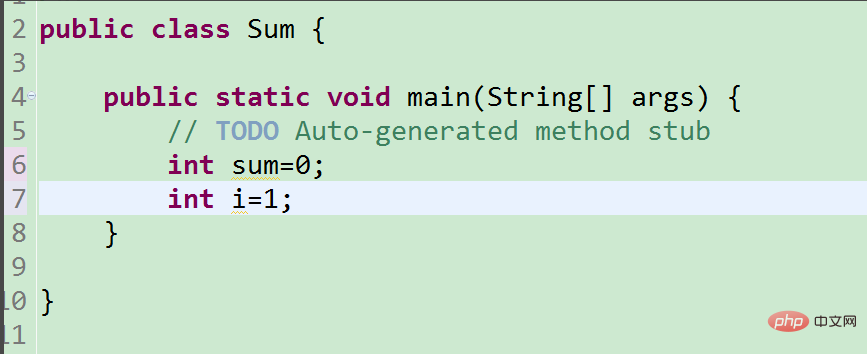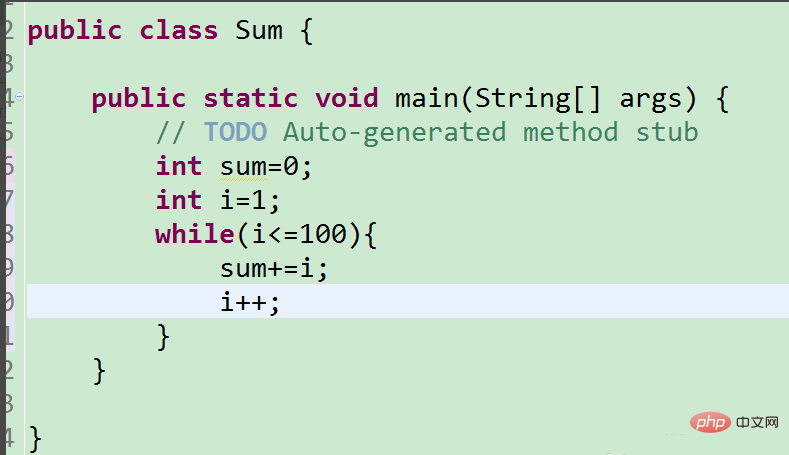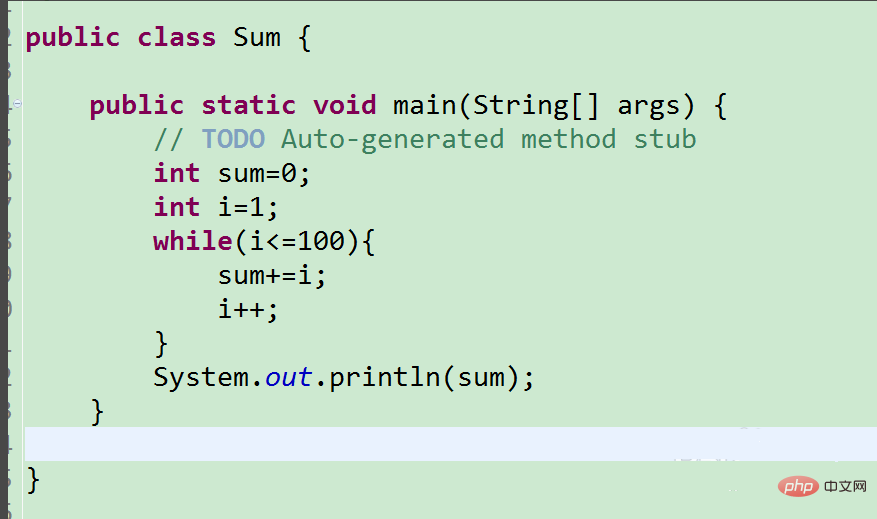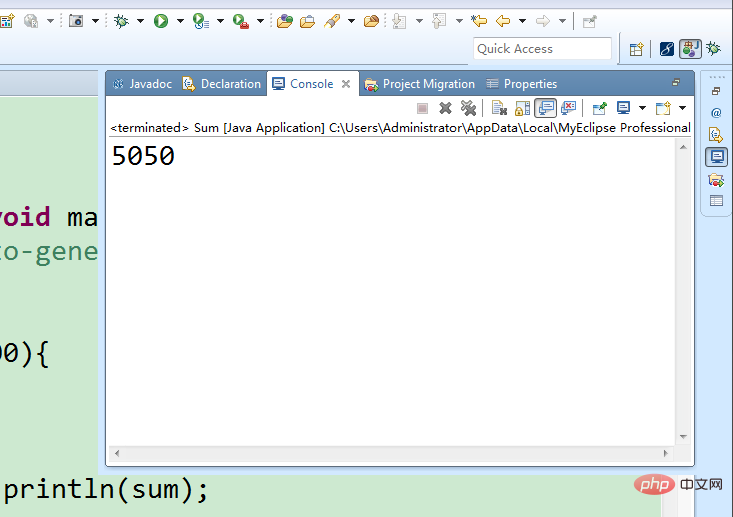While loop 1 adds to the sum of 100
The sum between 1-100, if we use ordinary addition operations, it will be very difficult. This is a waste of time, inefficient, and prone to errors. Here I use a while loop to show you, For beginners to exercise their ideas, it is still very useful to master basic programming.

First of all, we need to create a class in MyEclipse to perform calculations. When choosing a name, we must pay attention to it and be aware of the name, so that it will be easy for others. Understand what you are trying to do. (Recommended learning: Java Video Tutorial)
 After it is established, we will start operating the code. If we want to perform calculations at this time, we have to define the variables we need, so that it is convenient for us to perform calculations
After it is established, we will start operating the code. If we want to perform calculations at this time, we have to define the variables we need, so that it is convenient for us to perform calculations
 After defining the variables, we will start the loop. When i< ;=100, repeat the addition operation, assign the value of sum i to sum, and increment the value of i after each addition.
After defining the variables, we will start the loop. When i< ;=100, repeat the addition operation, assign the value of sum i to sum, and increment the value of i after each addition.

When we loop, we must pay special attention not to forget i; if we do not write this, it will not close, in which case we will output.


For more Java-related technical articles, please visit the Java Development Tutorial column to learn!
The above is the detailed content of While loop 1 adds to the sum of 100. For more information, please follow other related articles on the PHP Chinese website!

Hot AI Tools

Undresser.AI Undress
AI-powered app for creating realistic nude photos

AI Clothes Remover
Online AI tool for removing clothes from photos.

Undress AI Tool
Undress images for free

Clothoff.io
AI clothes remover

Video Face Swap
Swap faces in any video effortlessly with our completely free AI face swap tool!

Hot Article

Hot Tools

Notepad++7.3.1
Easy-to-use and free code editor

SublimeText3 Chinese version
Chinese version, very easy to use

Zend Studio 13.0.1
Powerful PHP integrated development environment

Dreamweaver CS6
Visual web development tools

SublimeText3 Mac version
God-level code editing software (SublimeText3)

Hot Topics
 In C language, what is the difference between while(1) and while(0)?
Aug 31, 2023 am 10:45 AM
In C language, what is the difference between while(1) and while(0)?
Aug 31, 2023 am 10:45 AM
We know that in C language, 'while' keyword is used to define a loop that works based on the condition passed to the loop. Now, since the condition can have two values, true or false, the code inside the while block will be executed repeatedly if the condition is true and will not be executed if the condition is false. Now, by passing parameters to the while loop, we can differentiate between while(1) and while(0) because while(1) is a loop where the condition is always considered true and hence the code inside the block will start executing repeatedly. Furthermore, we can state that it is not 1 that is passed to the loop that makes the condition true, but if any non-zero integer is passed to the while loop, then it will be considered as the true condition, so
 Usage of while
Sep 25, 2023 am 09:47 AM
Usage of while
Sep 25, 2023 am 09:47 AM
The usage of while is "while condition: code block". The condition is an expression. When the condition is true, the code block is executed, and then it is judged again whether the condition is true. If it is true, the code block continues to be executed until the condition is false. . while is a commonly used loop control statement, used to repeatedly execute a block of code when certain conditions are met.
 Is while a keyword in go language?
Jun 04, 2021 pm 05:01 PM
Is while a keyword in go language?
Jun 04, 2021 pm 05:01 PM
In the Go language, while is not a keyword. You can use the for statement plus break to achieve the effect of a while loop, such as "for {sum++ if sum>10{break}else{...}}". The go language has 25 keywords such as break, default, func, select, case, defer, go, map, else, goto, for, if, var, etc.
 Detailed explanation of PHP While loop: Comprehensive mastery of loop principles and application scenarios
Apr 09, 2024 pm 03:27 PM
Detailed explanation of PHP While loop: Comprehensive mastery of loop principles and application scenarios
Apr 09, 2024 pm 03:27 PM
While loop is a control flow structure used to execute statements repeatedly until a condition is false. The principle is to check the condition, and if it is true, execute the loop body, and then check the condition until the condition is false. It is suitable for situations where an operation needs to be performed repeatedly, an operation needs to be performed when a condition is true, or a loop needs to be jumped out based on a condition. Practical examples include printing even numbers, calculating prime numbers, and using the break statement to break out of loops.
 What are the common flow control structures in Python?
Jan 20, 2024 am 08:17 AM
What are the common flow control structures in Python?
Jan 20, 2024 am 08:17 AM
What are the common flow control structures in Python? In Python, the flow control structure is an important tool used to determine the execution order of the program. They allow us to execute different blocks of code based on different conditions, or to execute a block of code repeatedly. The following will introduce common process control structures in Python and provide corresponding code examples. Conditional statements (if-else): Conditional statements allow us to execute different blocks of code based on different conditions. Its basic syntax is: if condition 1: #when condition
 Detailed explanation of the function and usage of break keyword in PHP
Jun 28, 2023 pm 06:39 PM
Detailed explanation of the function and usage of break keyword in PHP
Jun 28, 2023 pm 06:39 PM
Detailed explanation of the role and usage of the break keyword in PHP In PHP programming, break is a control flow statement used to interrupt the current loop or switch statement and jump out of the loop or switch. This article will introduce in detail the role and usage of the break keyword. 1. Break in a loop In a loop structure, the function of break is to terminate the loop early and jump out of the loop body to execute the code after the loop. Common loop structures include for, while and do...while. in for loop
 How to use the while statement in java
Apr 19, 2023 am 09:28 AM
How to use the while statement in java
Apr 19, 2023 am 09:28 AM
Note 1. The Chinese meaning of the while keyword is when..., that is, when the condition is established, the corresponding code is executed in a loop. The while statement is the basic structure in the loop statement, and the syntax format is relatively simple. Execution process 2. When executing a while statement, first determine the loop condition. When the loop condition is false, the subsequent code of the while statement is directly executed. When the loop condition is true, the loop body code is executed and the loop condition is determined until the loop condition is not established. Example inti=1;intsum=0;while(i
 Using PHP While Loop: Improve Program Efficiency and Readability
Apr 09, 2024 pm 12:18 PM
Using PHP While Loop: Improve Program Efficiency and Readability
Apr 09, 2024 pm 12:18 PM
PHPWhile loop improves efficiency and readability: By using termination conditions and encapsulating repeated code, while loops can reduce calculations, enhance readability, and simplify code.






